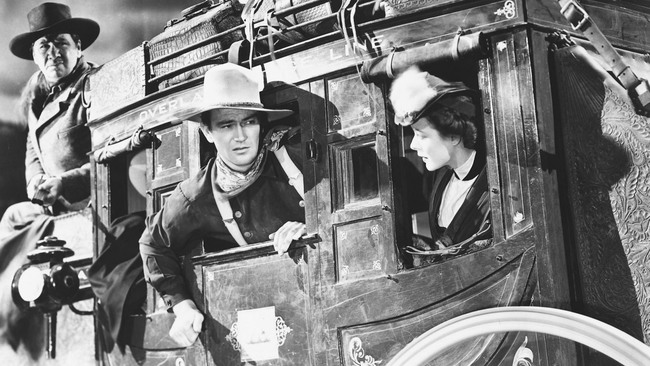Wayne and Ford and More

In Wayne and Ford: The Films, the Friendship, and the Forging of an American Hero, Nancy Schoenberger “has hidden a provocative thesis,” suggests Stephen Metcalf, writing for the Atlantic. “She asks us to remember the beauty of masculine self-mastery as Ford presented it in his very best films. And yet, from the bulk of the evidence here, masculinity (like the Western) is a by-product of nostalgia, a maudlin elegy for something that never existed—or worse, a masquerade that allows no man, not even John Wayne, to be comfortable in his own skin. . . . Ford was terrified of his own feminine side, so he foisted a longed-for masculinity on Wayne. A much simpler creature than Ford, Wayne turned this into a cartoon, and then went further and politicized it. There was an awful pathos to their relationship—Wayne patterning himself on Ford, at the same time that Ford was turning Wayne into a paragon no man could live up to. . . . The invention of John Wayne—is there a more primal scene of masculinity being stripped of utility and endowed with dubious political karma?”
Further in, Metcalf writes: “To read Scott Eyman’s Hank and Jim: The Fifty-Year Friendship of Henry Fonda and James Stewart . . . is to relive the fate of the Greatest Generation as it moved through war, affluence, routine, boredom, and finally, well-earned retirement.”
Julie Jones’s translation of Max Aub’s Conversations with Buñuel: Interviews with the Filmmaker, Family Members, Friends and Collaborators, originally published in Spain in 1985, now appears in English for the first time in an expanded edition with more interviews and fresh notes. “If there’s one essential takeaway,” writes Jeremy Carr for Film International, “it’s that Luis Buñuel thoroughly enjoys his freedom and his fun. As mentioned throughout the book, his infectious sense of humor includes practical jokes and bawdy gestures, while so many of his comments suggest a sly sense of knowing far more than he lets on.”
Peter Biskind, author of Easy Riders, Raging Bulls: How the Sex-Drugs-and-Rock ’N’ Roll Generation Saved Hollywood and Down and Dirty Pictures: Miramax, Sundance and the Rise of Independent Film, among other books, reviews three for the New York Times:
- Dave Kehr’s Movies That Mattered: More Reviews From a Transformative Decade. “[A]s with all the great reviewers—Pauline Kael, Andrew Sarris, Manny Farber—Kehr’s reviews fly free from their ostensible subjects to become species of cultural criticism. Agree with his opinions or not, they’re always smart, lucid, well argued and witty.”
- Jim Shepard’s The Tunnel at the End of the Light: Essays on Movies and Politics. “Shepard is explicitly interested in the way in which movies operate to enhance, and occasionally dissent from, our commonly held political beliefs.”
- Eric Lax’s Start to Finish: Woody Allen and the Art of Moviemaking. “If nothing else, this study should put to rest a prevalent, although peculiar, notion that Allen is lazy.”
At the top of his interview with Noah Isenberg for the Pennsylvania Gazette,John Prendergast notes that We’ll Always Have Casablanca: The Life, Legend, and Afterlife of Hollywood’s Most Beloved Movie “doesn’t lay to rest the question of why this Hollywood product—among the hundreds released by Warner Brothers and its fellow studios during World War II—has meant so much to so many for so long. But it does offer a lively, thorough, and often surprising narrative of how that emotional response has played out both here in the United States and around the world in the seventy-five years since its debut in November 1942 (just weeks after Allied troops in North Africa liberated the real Casablanca).”
Image above: John Wayne in John Ford’s Stagecoach (1939). For news and items of interest throughout the day, every day, follow @CriterionDaily.



